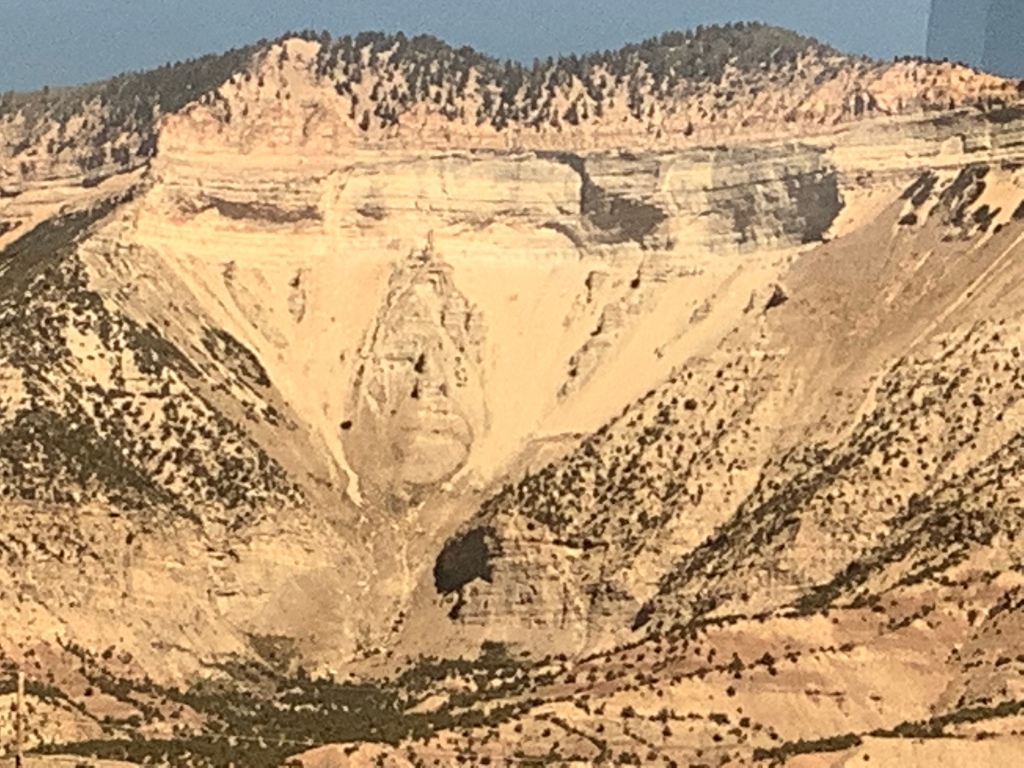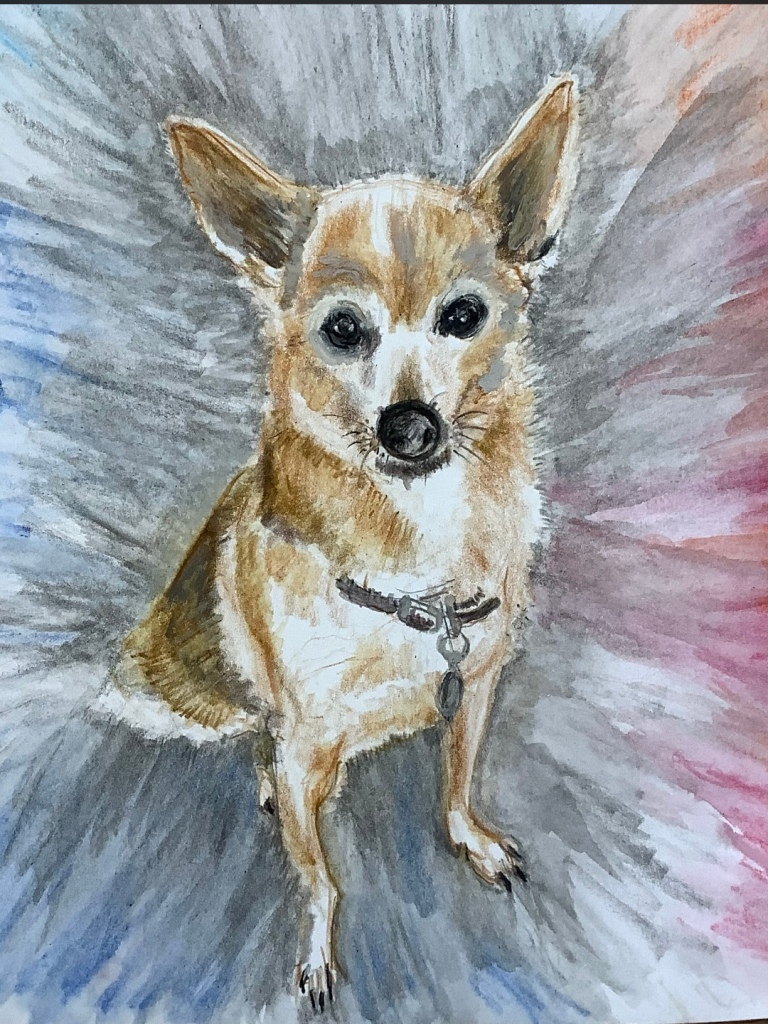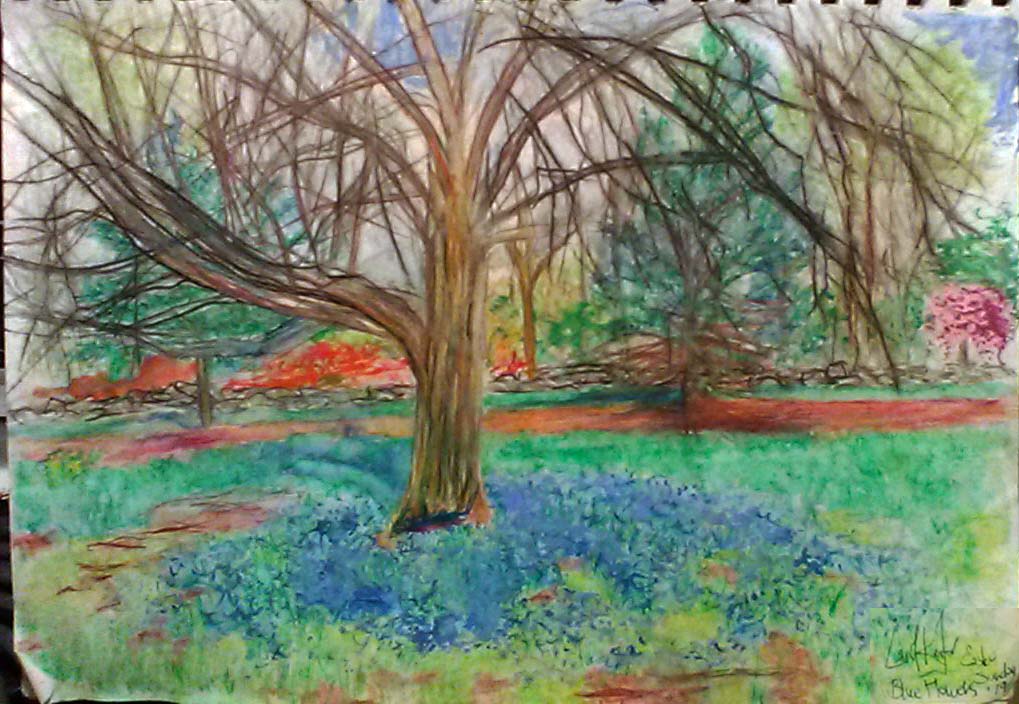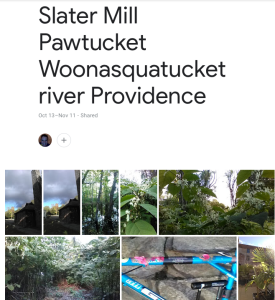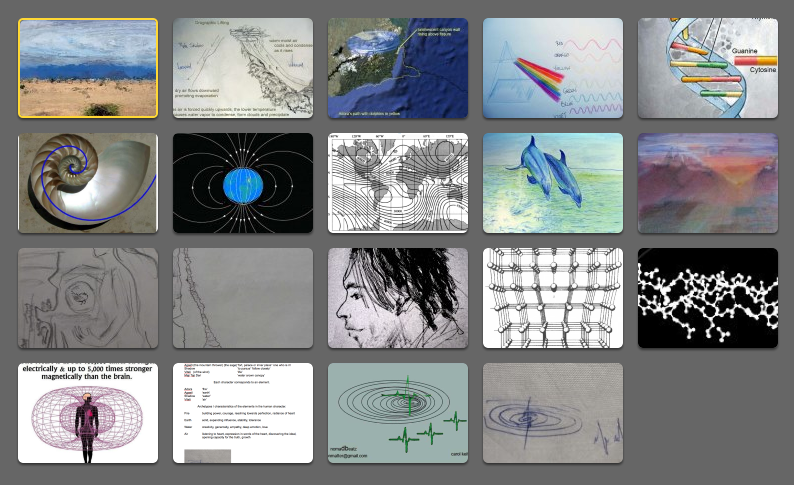I have an idea which continues to evolve. I would like to know if any of you recipients – environmental organizations or individuals – can join with me or bring me under your wing so that we can do this together? I’d like to quickly put together a concise plan as a pitch for next week at the Paris Climate Talks, for people to take home and ponder. I have not yet booked a flight, however am willing to do so within the next 24 hours and will work continuously with others with research and development and writing a proposal sketch to present. By its nature, it involves many; a consensus of scientists, business advocates, governmental support as well as people within the communities where these physical structures would be built. It begins in Europe. The original idea which I had presented in August of this year, has a new twist. Specifically the manpower involving the placement, education and training of refugees, who working together with communities throughout Europe, would aspire to be cooperatively working in the implementation of structures that would be greening the environment and have business models that lead to a democratization of wealth. It would be a win:win situation; helping the climate, replacing petroleum and coal and dirty industries with clean ones, greening the environment, creating jobs for local European communities and for refugees, and would be empowering for any involved. I say yes, the money is there, it simply needs to be redirected; i.e. from weapons and military, to education and the building of a green infrastructure throughout Europe and the world.
In the 1970s, refugees from Vietnam, ‘boat people’ were introduced into various communities in the United States. My mother in central Pennsylvania volunteered to help one particular family which she was assigned to. She would go to their home regularly to tutor the family in English and help the three sons with their home work. Two of the boys became dentists and opened up a joint practice in the town I was raised in which just celebrated their 20th year anniversary. The other son is a doctor. The relationship between the two families has lasted to the present day. Their entire family have remained friends, and I’ve had several dental appointments with them when passing through town. They are genuinely kind people who have remained grateful and loyal to the initial help they received, ever since. In other words, many of the refugees are good people who wish simply to have security, opportunities for education and development for themselves and their children. In many ways their intent and self-determination will enhance the local communities they’ve been introduced into and ‘give back’ the chance they were given to survive and thrive.

Word cloud of involved actions in EChOACTiVate
This was my initial sketch – it’s the same information. I particularly need guidance in finding the right contact people and groups, to help to kindle this idea. I would appreciate any suggestions!
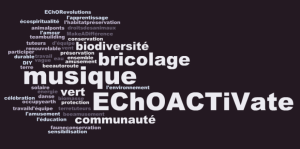
lets mots, les activité
pour EChOACTIvate
Often the biggest obstacle is not knowing exactly what we can do, or how to get started.
Often taking the first step is the hardest! Even finding information of how to accomplish things may involve more time than you feel that you have.
That’s where EChOACTiVate comes in!
This would at the same time deal with the world climate crisis by developing and building renewable energy structures, in areas where these are amenable and relevant to that environment. The systems would require monetary investment, yet ideally I visualize creating operations that are cooperative in nature, so that the builders and owners distribute the wealth among themselves and into the community, a more democratic form of business. Along with scientists and developers, I foresee an operation that would involve education and training, and finding in addition to citizens of that community, a placement of refugees, who would also be trained to be the man power behind the implementation of these renewable energy structures, community gardens, the building of literally green buildings, a planting of gardens and flowers and trees to create bee-highways, etc.
I had already conceived of this as a means of bringing together communities to participate, with the addition of a nature of celebration and gathering, with music together with the education. It has evolved however in the last week, in light of the continued incidents of terror around the globe. I feel that the edge of the sword of terror – if you will – is the reaction of the more radically charged Islamic peoples to the inequities and economic domination of the Western world, a structure that has been filtering throughout the world, which increases economic inequality and rather than delivering messages of cooperation, delivers ones of competition and materialism.

was EChOACTiVate ist
I would like people to join together with me or to invite me to begin delegating this idea into group that can manifest this. I need business minds, system developers, negotiators, lawyers, scientists and people passionate about the environment and animal habitat renewal and the democratization of wealth and power throughout the planet.

lo que tu puedes hacer con EChOACTiVate
Calling for EChOACTiVate Partners & a Core Team: to join and help to create the Non-Profit Mobile Task Force igniting Music, Education and ECOACTiV initiatives in communities around the world. The echo of results will propel others to also EChOACTiVate!
Contact me if you wish to partner, participate or guide me regarding what organizations may wish to act as a financial umbrella. ¡ echoactivate@gmail.com !
A myriad of individuals and environmental organizations have been warning as well as educating us about Climate Change and Global Warming and the continued threat of habitat loss and the destruction of many species. They inform us that we must change, that we need to act. It is clear that industry, particularly the dirty ones such as coal and petroleum, are cause to the more sweeping and devastating injuries to the the health and well-being of humans and species all over the planet. Yet our individual actions, collectively have wrought a lot of destruction, which can be reversed, through our adopting new habits. Certainly Obama’s new hislegislation will effectively persuade these larger monolithic companies to shift their practices, yet our future is also in our own hands. Our actions or non-action will determine our fate.
As we each learn – and share that information – about what we can do to transform our environments positively through action and taking ownership for its protection every where we go, we will produce dramatic results. Our individual actions will not only raise the quality of our own lives and the spaces we inhabit, but will collectively have an enormous impact. Since all of life is entirely interdependent, what we improve in our immediate environments will echo, and spread all over the planet. Through ‘dis-ease’, we will birth the remedies, to the point that they are the trend.
Various groups have been guiding us to have a voice among our legislatures. They offer solutions for what we can do. Climate Change and World Wildlife Fund and What We Can Do. Avaaz has a Avaaz has a Climate ToolKit. Recently Pope Frances expressed the urgent need of the world population to take action and ownership with his Pope Francis’ Encyclical: “Faith Climate Action Kit”. In the last 48 hours, the United States President Barack Obama addressed this urgency, pleading for the American people (and all the World) to take this seriously as a fact, and to ACT, with his “President Barack Obama’s “America’s Clean Power Plan””
Just as a flame or campfire draws peoples’ attention, so is music something that captivates and entrances people. Music can cause people to stop in their tracks. It engages all regardless of their cultural heritage or economic ‘status’. Music attracts the young and the elderly. It is a focal point. Music drives our passions. It is close to our hearts. That’s why EChOACTiVate is environmental action for the climate that is musically driven! Music will be the element that brings people together. The glue for social cohesion. And since we all have subjective musical tastes, EChOACTiVate will have to accommodate all sorts of musical tastes 🙂 EChOACTiVate will provide all sorts of music – from classical to country, rock to jazz, folk to punk – depending on the tastes of the particular community we engage with. Music is a force which inspires and energizes! EChOACTiVate will coordinate ecological action by bringing different members of the community into groups, according to their capabilities and interests.
Presently, we are at a pivotal point of urgency in terms of how our individual and collective actions and habits affect our environment. Our planet is either our hell or our heaven. If we continue along without doing anything and rely on ‘old world’ methods of generating power and fuel, our non-action will wreak more havoc and irreversible devastation.
Yet if we all work together and educate one another to make changes in our individual habits and choices towards investment in clean, renewable energy and fuel sources and divest from dirty energy, we will collectively impact our environment in an extremely positive way.
Our choices, habits and actions will make our own neighborhoods and towns more inviting and healthy for not only the humans who live there, but all the other indigenous creatures.
It is immanently clear that it is not our planet that is in peril, but the lives of most of the species inhabiting it. Our proactive actions must start imminently !-)
That’s where you, the public comes in. Let’s do this together. Let’s EChOACTiVate
EChOACTiVate is a community outreach program in the form of a mobile citizen action campaign. Like a ‘food truck’ that is mobile, EChOACTiVate is a ‘music/information stage’. It is a virtual portal of information to inform and act as a central information exchange point as well as a physical mobile team, which visits communities worldwide, to introduce the ‘How To’s” of the action the community decides to invest in, and catalyzes them to take implement their actions, through education and guidelines from mini DIY Do-It_yourself projects to more robust ones.
Arriving to the community to set up the stage, EChOACTiVate will coordinate the music and information to inspire and set the guidelines for task orientation, from the beginning stages through to its completion. EChOACTiVate will gather people together to initiate discussions on initiatives and help the members of the community to get started.
The projects are anything from education about what types of foods to eat and physical activities that can act as health prevention, to how to create friendly habitats in your own back yards and public spaces to attract pollinators and ensure the survival of many of the creatures that share our immediate environment. EChOACTiVate activities cover a vast breadth of choices. From planting trees, community gardens, to planting flowers and vegetation in your own backyards and on vertical fences and walls to attract biodiversity, creating bee-highways, land bridges over motorways for the safe passage of indigenous animals, DIY (do-it-yourself) installation of solar panels, windmills, wave and biomass energy procedures, trash clean-Up, ocean cleanup, ocean plastic removal, info-workshops on recycling and water conservation. EChOACTiVate will also provide and exchange information on more medium and long-term projects, demonstrating projects that are proven effective that require a team of scientists and engineers to construct.
We are at a tipping point concerning human induced climate change, which negatively impacts the lives of all species on the planet.
This has come about through the actions of the human species, and it can be reversed through the actions of the human species. If we physically and socially join together in our actions, it will make them that much easier to accomplish and more fun.

DoTheMath Gobal Climate Crisis Kumi Naidoo Greenpeace website
We all sometimes need that extra incentive. Coordinated through exchanges between our web-based non-profit and visiting team with a community, EChOACTiVate will deliver the information and the tools for that community of people to get started. The EChOACTiVate team will ‘land’ in a community through coordinated bi-lateral dialogue with a neighborhood or community that elects to take some ECOATIV measures. The mobile EChOACTiVate team will arrive in a town in the form of a one or two-day centralized stage. Where they combine music celebration with an information portal, that will organize that community into implementing action. The community will choose what projects are most relevant and needed in their area. The EChOACTiVate core team and volunteers will facilitate getting the community started; through providing the education, information – in the form of speakers and work-shops – to organize that community in their acquisition of tools (through local businesses) to mobilize them into action.
There are plenty of DIY – Do It Yourself – projects that citizens can implement through working together for a short period of time. EChOACTiVate will work with the consensus and the relevance of what a community needs and help them to get started. The capability and the means will come through people working together.
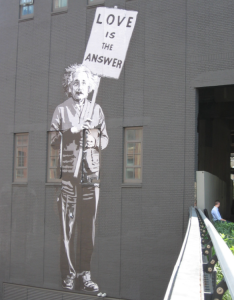
midsummer hitch nYc Einstein Love
EChOACTiVate
>>>>>introduces ecological and environmental proactive measures to individual communities, with music as the initial community binding glue. Music is often what brings people together. It is the virtual maypole, around which EChO -ReVoLuTioN unfolds >>> as a celebratory means of bringing people together and stepping out of their routine. And as communities and individuals empower themselves through their own works, their efforts and accomplishments will echo to other communities, giving others’ incentive to participate in their own EChO project.

MeaningS of EChO
That’s where you, the public comes in! Together we can do this! Each ECOACTV action will echo and inspire other communities to do the same. Our actions will reverberate. Others will be inspired to demonstrate how their community EChOACTiVated to make wonderful differences.

Echo by Alexandre Cabanel 1874 Mount Kithairon
Reiterating: EChOACTiVate is both a cyber portal providing information about the divers ECOACTV DIY Do-It-Yourself projects available for that community to decide upon, and a mobile stage (built of a the core EChOACTiVate team and volunteers) that arrive to the community to provide workshops, speakers and the strategy of what they will need to do to implement their plans of action.
I am one individual with a vision. I know that I want to participate and I know that it is dramatically more engaging to have some sort of celebration with music, to get my attention and find joy in socializing and participating. I wish to make EChOACTiVate a non-profit formed through a number of people who will partner with me. The more quickly I find people who wish to help me to build this, the more quickly we can use our skills and talents to make this dream into a reality.
Calling for partners and/or remote coworkers who work on a consultant/as needed basis: web developers, web designers, app developers, lawyers, accountants, program directors, educational coordinators, biologists, zoologists, climatologists, engineers, researchers, traveling fact gatherers of environmental adaptation success stories Worlwide, artists, musicians, stage hands, a mobile team of presenters and speakers, fundraisers and funding.
Schools could get involved in ‘Expeditionary Learning’ projects, learning by doing. Environmental projects involving energy conservation and the preservation of animal habitats involve: chemistry, biology, statistics, mathematics, geography, geology, environmental sciences and physics – all sorts of learning. As communities become involved to EChOACTiVate, they will learn not only about the dangers of non-action, with respect to erosion, draught, effects of pollutants, the dangers of industrialized farming and fishing and GMO’s, but they will learn about healthy alternatives and what actions – no matter how small – from preventive health measures to the ‘how-to’s’ of getting started in their project(s)>to make their immediate environments more eco-friendly and pleasant for all species.
Corporate, State or Federal could match funds raised by townspeople, (fragment of the U.S. Political campaign budget 🙂 and Federal andState government subsidies or drives to support projects from the simple to the more technically specialized projects involving higher material and equipment costs.
Putting people to work on a Worldwide level, one community at a time. ecoactivate.org will compile lists of the array of projects that communities opt to engage in and monitor and correlate the exchange in open forums in which the community decides on what they wish to do to be ECOACTV in their area and what they’ve accomplished, in the EChOACTiVate campaign rippling across the planet. ecoactivate.org is the portal to gather and exchange information, to coordinate the mobile EChOACTiVate presenters and musicians to come to your town in a face-to-face hands-on delivery and designation of plans for the community itself to implement.
This is a rough sketch! I need you to help me transform it into a reality.
Contact me if you wish to partner, participate or guide me regarding what organizations may wish to act as a financial umbrella. ¡ echoactivate@gmail.com !
§ a web-based interactive information portal ecoactivate.org (not yet constructed) providing information in categories of work projects and DIY information from simpler to more technically complex projects. The EChOACTiVate website will provide open forums for communities to investigate their options, suggest ECOACTV projects of their own and as well as to ask questions and work out schedules. The website will also project what different communities have accomplished with more success stories.
§ a mobile unit with a core team of organizers and educators visiting communities to catalyze their projects: including special guest musicians, educators, specialists and technicians upon Touch Down in that community. This occurs on a one or two day central area within the town, where information and a plan of action for the community to take for the project(s) they have decided to embark on, is provided.
§ This takes place on the “ECOACTV Opening Day’ – a celebration with music and education, vendors and informational work-shops. The EChOACTiVate core team and volunteers touch down to provide guidance and incentive, and certainly helping hands in the beginning stages.
§ The community has a continual ‘two-way’ information exchange, from offering information before the EChOACTiVate group has arrived in their town, to participating by inviting their own town musicians, bands and dj’s to perform for the Informational Opening day as well as during the days or weeks that the community is working on their project. I haven’t worked out the local noise ordinance rules, but this is an exceptional event during exceptional times requiring awareness and action.
§ The successes of various groups will be shared on the EChOACTiVate website and Facebook page as well as through an EChOACTiVate app for mobile devices, so that neighborhoods and communities can compare and display what they’ve accomplished; as well as to provide their feedback, comments and suggestions.
§ whereas digital technology can often isolate people, it can also bring them together to physically join one another:
• apps to record community progress & success stories
• competitions and challenges between communities
§ music is key; with live entertainment from musicians and bands on the opening day and special guests. The town can contribute their own live entertainment with musicians, bands creating their own acts on the Opening Day. Special guests will participate.
§ The Touch Down Opening Day will be the arena for the local citizens to assemble in a celebratory way with the music and food and/or product vendors. Side by side, they will participate in actively learning and sharing information, prior to being organized into groups to work together on teams, according to their physical size, strength, skills and expertise.
§ At this Opening event a series of workshops and meetings will take place to lay out the plans.
§ If a project thaT has been discusses between community members and the EChOACTiVate team in advance is of a more complex nature, EChOACTiVate will help to find consultants to bridge the information gap and parlay what the community’s options are. Educators, speakers, technical consultants and habitat specialists would contribute information on a variety of conservation and preservation topics as well as on themes specifically relevant to the articular chosen project by the community: to assist in determining the material, hardware and man-power needs to get the project started.
People do best, what they like to do most.
§ The EChOACTiVate website will also host live-streamed interactive telecasts of participating groups in other countries, as info-seminars as well as speeches consulting experts in the fields regarding whatever technology is being researched, developed and implemented.
§ As groups EChOACTiVate, their actions and own stories are shared by word-of-mouth, visitors to their town, twitter, Facebook, through the EChOACTiVate App revealing achievements and and on the echoactivate.org Success Stories section.
Each metamorphoses will echo…and invite others to EChOACTiVate and share their own success stories.
Did you hear what Memphis, or Cincinnati, Los Angeles, Pittsburg, Brooklyn, New Dehli, Sao Paulo, Montpelier, Barcelona or Guangxi did? What are you waiting for? Let’s do this. Let’s EChoACTiVate!
Engaging and coordinating local townspeople, businesses and industries to participate, draw resources and form teams of man-power to join together and take action together. Resulting in improved quality of their own environment and learning about all the ways that we the human species can adopt habits and develop awareness about our connection to our environment and to all other species. An public engagement in an environment of celebration, fun and learning, that delights and empowers the people as they transform their own environment.
This idea resulted from Carol Keiter, the blogger
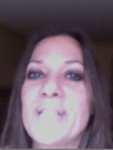
Carol Keiter informational architect of EChOACTiVate

Carol holding the plastic globe
in her aim to follow her own path.

A tagcloud summing up Carol Keiter’s interests and passions.
Well, why not? > Donations showing your support of the evolution of EChOACTiVate as well as Carol Keiter’s writing, eBook, music composition, photography & illustrations are gratefully accepted! 




